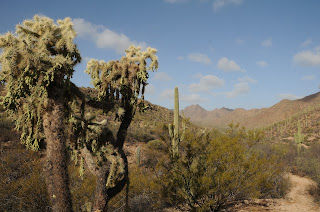In his essay The Decay of Lying, Oscar Wilde stated: “Life
imitates art far more than art imitates Life.” This concept has been fodder for
arguments among philosophers and pundits since ancient times. Throughout
history, notable minds have contributed to the fray.
“Art is imitation and that’s bad.” Plato
“Art completes what nature cannot bring to
finish. The artist gives us knowledge of nature's unrealized ends.” Aristotle
“Art is what you can get away with.” Andy
Warhol
 |
| Genuine and imposter saguaros mingle on the hill. |
The cleaver shells disguise
cellphone towers. While the structures’ purpose and placement are cause for pause,
consider of the big picture before condemning. Case in point, on a recent
visit, I observed a couple making comments about how awful the towers look
while snapping photos of them with their cell phones. So, essentially we have an ersatz life form
concealing the means to make visual facsimiles that will undoubtedly end up on
a social media forum that apes actual living. Ironic, methinks.
Moving on, there’s more to
the preserve than the gallery of paradox. If the 6-acre parcel in Cave Creek isn’t
the tiniest hiking destination in Arizona, then it’s certainly a contender. Situated
on a mini ridge behind the town library, the site was the first property
purchased by the Desert Foothills Land Trust, a nonprofit, all-volunteer
conservation organization which protects over 680 acres on 23 preserves in the
Sonoran Desert Foothills. The teeny
hillside features gardens with placards identifying plants, seating areas and a
short hiking trail with interpretive displays about the life cycle and survival
strategies of saguaros. Want to know how to tell the difference between a
barrel cactus and a saguaro? There’s a sign for that. In addition to its
educational features and adjacent media center, the trail showcases views of Black Mountain and
the wild ranges of Tonto National Forest. After exploring, let the aroma
of mesquite drifting from local eateries lure you to a cozy table to discuss the intersection of art
and nature over drinks, grub and a smart phone.
 |
| Black Mountain seen from Saguaro Hill Preserve |
LENGTH: 0.5 mile
RATING: easy
ELEVATION: 2240’ – 2280’
HOURS: open every day from dawn
to dusk
GETTING THERE:
From Cave Creek Road, turn
north on School House Road and continue 0.1 mile to the Desert Foothills library
parking lot.
INFO: Desert Foothills Land
Trust










